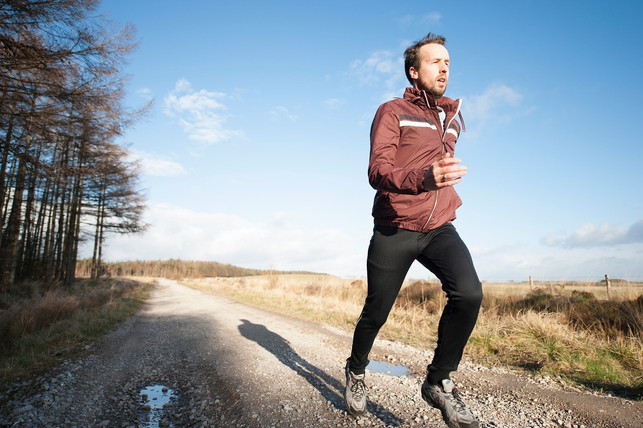
Aerobic exercise can help you become more efficient, protect against illness, and improve sleep. You can find out why this form of training offers so many advantages here.
Aerobic training initially sounds like a somewhat unwieldy technical term. But you’ve probably already done aerobic training yourself, because any form of moderate endurance sport is considered aerobic training. These include casual jogging and cycling, swimming or even brisk walking.
However, to ensure that you remain in the aerobic range, it is important not to train too intensively during endurance sports. So it’s worth slowing down so you can benefit from the benefits of aerobic training.
What is Aerobic Training?
The term “aerobic” comes from Greek and means “with oxygen”. Aerobic training describes forms of exercise in which the body uses oxygen to generate energy.
Here’s what happens: When we move, our muscles need energy. During aerobic exercise, this energy comes primarily from carbohydrates and fats. The oxygen we breathe ensures that these nutrients are burned efficiently in the cells. The result is a long-lasting energy supply that allows us to stay active for longer periods of time.
In contrast to this is anaerobic training. The term “anaerobic” means “without oxygen”. During anaerobic exercise such as strength training or sprinting, the body cannot provide oxygen quickly enough to produce the energy it needs. Instead, it uses energy sources that do not require oxygen and are already available in the body. This is faster, but our body can only provide a limited amount of energy. This also explains why we get tired more quickly during anaerobic exercise, according to the European Food Information Center (EUFIC).
However, aerobic and anaerobic training are not clearly separated categories. According to the EUFIC, in most sports the two metabolisms complement each other. It therefore makes more sense to understand the two terms as end points of a scale.
Aerobic training: It has these benefits

(Photo: CC0 / Pixabay / renategranade0)
Aerobic exercise has a positive effect on our health in different ways:
-
Strengthens the cardiovascular system. According to Healthline, regular aerobic exercise improves the performance of the heart. It becomes stronger and can pump more blood per stroke. This lowers the resting heart rate, makes us more efficient and relieves the strain on the heart in the long term. According to the spectrum, this reduces the long-term risk of cardiovascular diseases, diabetes, dementia or certain cancers.
-
Improves endurance. Due to the positive effects on our cardiovascular system, aerobic training increases the body’s resilience. After just a few weeks you will notice that you are fitter, can do sports for longer and tire less and less quickly.
-
Protects against diseases. Aerobic exercise strengthens the immune system. A 2018 study shows that older people had more active B and T cells in their blood after a few weeks of aerobic training. Both types of cells are involved in fighting off pathogens. According to the AOK, the more B and T cells we have, the less susceptible we are to chronic inflammation and infections.
-
Helps you lose weight. If you want to lose weight healthily, aerobic training is a good idea. Activities like moderate running or cycling boost your metabolism and burn fat. In addition, we burn more energy not only during aerobic training, but also for some time afterwards, according to the AOK. Combined with a balanced diet, moderate endurance training can help you lose weight.
-
Improves sleep. Regular aerobic exercise can help increase sleep quality. A 2010 study examined the effects of moderate endurance training in people with chronic sleep disorders. The result: The group that completed aerobic exercise for over 16 weeks reported increased sleep quality and longer sleep.
This is how you train aerobically

(Photo: CC0 / Pixabay / StockSnap)
If you want to do aerobic training yourself, you should use a heart rate monitor. According to the AOK, you can use a simple formula to calculate the pulse range in which your body works in aerobic metabolism:
- Subtract your age from the value 180. If you’re 30 years old, you’ll be 150.
- This value plus/minus ten beats determines your aerobic pulse range. So at the age of 30 it is between 140 and 160.
If you don’t have a heart rate monitor, there is another simple trick you can use to check whether you are still exercising aerobically. So you should make sure that you can still hold a conversation without any problems during endurance sports – the so-called talk test. The easiest way is to simply go jogging with another person and talk to each other while jogging. If you notice that you can no longer speak complete sentences, you are probably already in the anaerobic range. Then you should reduce your pace a little.
Note: Endurance sports are not equally suitable for everyone. People with certain previous illnesses should only reintegrate sport into their lives under medical supervision. It is also advisable for pregnant women to adapt their own exercise routine to the respective month of pregnancy. You can find out more about this here: Sport during pregnancy: Which sport and how much of it?
Read more on Techzle\.com:
- Doing sports with a hangover? Whether exercise makes sense now
- Do exercise in the morning or evening? Which is better
- Do you exercise regularly despite everyday stress? Get fit with these tips
** marked with ** or orange underlined Links to sources of supply are partly partner links: If you buy here, you are actively supporting Techzle\.com, because we then receive a small part of the sales proceeds. More info.